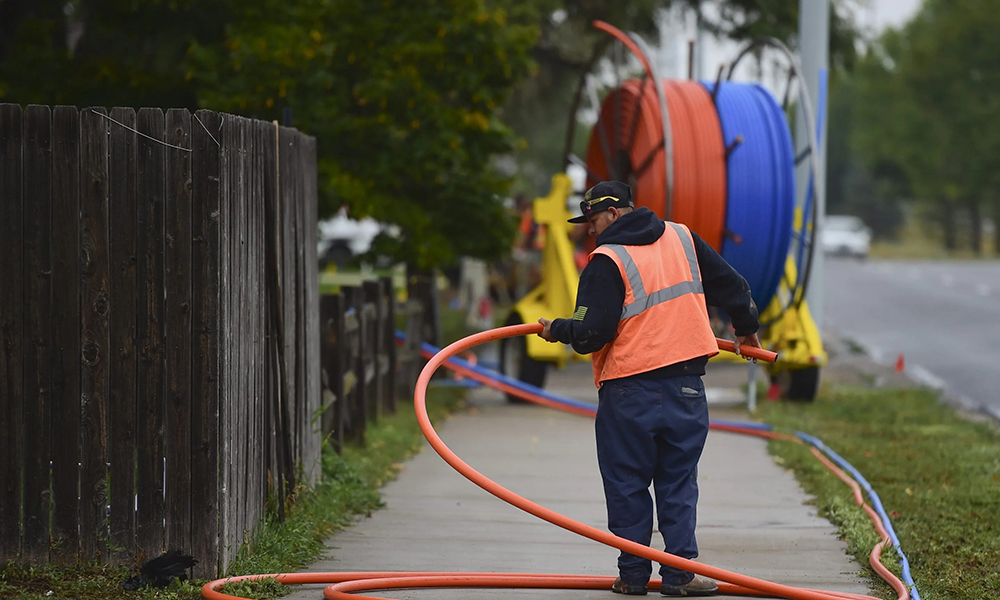
容易實(shí)現(xiàn)的部分已經(jīng)完成了。去年11月,,國會(huì)批準(zhǔn)了一項(xiàng)千載難逢的兩黨基礎(chǔ)設(shè)施立法,,其中包括650億美元的資金,該資金用于加速寬帶部署并幫助縮小美國持續(xù)存在的數(shù)字鴻溝,。
現(xiàn)在,,更艱巨的工作開始了:如何高效且富有成效地使用這筆巨款。
立法本身包括對將進(jìn)行資金分配的聯(lián)邦和州政府官員的建設(shè)性指導(dǎo),。我們可以從聯(lián)邦和州政府以前采取的舉措以及私營部門提供商過去和現(xiàn)在的經(jīng)驗(yàn)中收集更多有關(guān)有效寬帶投資的見解,。
牢記這些經(jīng)驗(yàn)教訓(xùn),以下三個(gè)基本原則有助于確保我們的寬帶投資獲得最大回報(bào),。
一刀切的做法不適合所有人
美國最大的特點(diǎn)之一是復(fù)雜多樣的地形和人口多樣性,,但談及聯(lián)邦基礎(chǔ)設(shè)施計(jì)劃時(shí),我們就不那么卓越了,。
美國國土遼闊而且非常多樣化,。各州之間以及各州內(nèi)不同的地方之間的實(shí)際情況差別很大。
在確定方案設(shè)計(jì)和目標(biāo)時(shí),,注重寬帶連接的政策制定者需要考慮多種條件,,從人口密度、平均收入,、地質(zhì),、地形到現(xiàn)有的競爭產(chǎn)品范圍。
密切配合
在聯(lián)邦政府提供資金的同時(shí),,寬帶計(jì)劃要想成功需要聯(lián)邦,、州、地方政府和私營部門之間密切合作,。地方領(lǐng)導(dǎo)人最了解當(dāng)?shù)氐奶魬?zhàn),,尤其是在早就承諾但仍未完全交付的聯(lián)邦寬帶地圖缺乏的情況下。
州和地方政府官員將更直接地監(jiān)督大部分支出和隨后提供的服務(wù),。各州可以從任命“寬帶沙皇”中受益,,從而專注于縮小數(shù)字鴻溝,調(diào)查可用性缺陷及其原因,,說服民眾使用寬帶,,并積極協(xié)調(diào)各方行動(dòng)。
聯(lián)邦政府官員可以從國家視角出發(fā),,在全國范圍內(nèi)找出可以在多個(gè)行政轄區(qū)復(fù)制的成功方法,。
在過去的二十年里,私營部門提供商投資了1.9萬億美元用于建設(shè)和運(yùn)營寬帶網(wǎng)絡(luò),,他們帶來了最重要的知識(shí),。雖然每個(gè)人都喜歡抱怨他們當(dāng)?shù)氐挠芯€電視,、無線或有線運(yùn)營商,但通過大量的基礎(chǔ)設(shè)施支出,,這些企業(yè)正帶頭建設(shè)美國的5G網(wǎng)絡(luò),。
優(yōu)先考慮連接性
我們的經(jīng)濟(jì)復(fù)蘇正面臨著持續(xù)性短缺、通貨膨脹和新冠肺炎疫情帶來的破壞這些挑戰(zhàn),。氣候變化導(dǎo)致與天氣有關(guān)的災(zāi)難帶來的損失越來越大,,教育成果仍然因種族而出現(xiàn)無法讓人接受的分化現(xiàn)象,地緣政治競爭者爭奪創(chuàng)新領(lǐng)導(dǎo)權(quán)和技術(shù)主導(dǎo)地位,。盡可能快地將所有美國人聯(lián)系起來將有助于我們應(yīng)對這些挑戰(zhàn),。
不幸的是,在美國建設(shè)基礎(chǔ)設(shè)施的成本比在大多數(shù)其他國家高得多,。雖然導(dǎo)致美國建設(shè)基礎(chǔ)設(shè)施成本較高和延誤時(shí)間較長的原因有很多種,,但官僚主義的惰性是成功部署寬帶的最嚴(yán)重障礙之一。
例如,,在路易斯安那州的杰斐遜教區(qū),,有數(shù)十份光纖部署許可證仍未獲得批準(zhǔn),其中一些許可證早在去年1月就已提交,。2021年3月,,教區(qū)承諾在兩周內(nèi)批準(zhǔn)許可證。然而幾個(gè)月后,,盡管教區(qū)委員會(huì)采取行動(dòng)敦促教區(qū)推進(jìn)許可證批準(zhǔn)進(jìn)程,,但教區(qū)的企業(yè)和居民仍在等待這一關(guān)鍵的基礎(chǔ)設(shè)施連通。
教區(qū)的擔(dān)憂主要集中在美觀方面,,這是因?yàn)樗麄兤谕笪磥淼墓饫w部署者在部署光纖之前拆除銅線,。除了威脅到仍然依賴銅線寬帶的客戶獲得持續(xù)服務(wù)外,這些反對意見還推遲了對更先進(jìn)網(wǎng)絡(luò)的投資,。
寬帶建設(shè)要想取得成功,,政策制定者需要明白國會(huì)撥款不是終點(diǎn),而僅僅是起點(diǎn)的終點(diǎn),。 只有通過與私營部門領(lǐng)導(dǎo)人合作,,向當(dāng)?shù)鼐用駥W(xué)習(xí),并優(yōu)先考慮官僚主義的靈活性而不是黨派意識(shí)形態(tài),,我們才能實(shí)現(xiàn)普及寬帶的目標(biāo)。(財(cái)富中文網(wǎng))
布魯斯·梅爾曼(Bruce P. Mehlman)是前美國商務(wù)部負(fù)責(zé)技術(shù)政策的助理國務(wù)卿,,也是互聯(lián)網(wǎng)創(chuàng)新聯(lián)盟的創(chuàng)始聯(lián)合主席,。
容易實(shí)現(xiàn)的部分已經(jīng)完成了。去年11月,,國會(huì)批準(zhǔn)了一項(xiàng)千載難逢的兩黨基礎(chǔ)設(shè)施立法,,其中包括650億美元的資金,,該資金用于加速寬帶部署并幫助縮小美國持續(xù)存在的數(shù)字鴻溝。
現(xiàn)在,,更艱巨的工作開始了:如何高效且富有成效地使用這筆巨款,。
立法本身包括對將進(jìn)行資金分配的聯(lián)邦和州政府官員的建設(shè)性指導(dǎo)。我們可以從聯(lián)邦和州政府以前采取的舉措以及私營部門提供商過去和現(xiàn)在的經(jīng)驗(yàn)中收集更多有關(guān)有效寬帶投資的見解,。
牢記這些經(jīng)驗(yàn)教訓(xùn),,以下三個(gè)基本原則有助于確保我們的寬帶投資獲得最大回報(bào)。
一刀切的做法不適合所有人
美國最大的特點(diǎn)之一是復(fù)雜多樣的地形和人口多樣性,,但談及聯(lián)邦基礎(chǔ)設(shè)施計(jì)劃時(shí),,我們就不那么卓越了。
美國國土遼闊而且非常多樣化,。各州之間以及各州內(nèi)不同的地方之間的實(shí)際情況差別很大,。
在確定方案設(shè)計(jì)和目標(biāo)時(shí),注重寬帶連接的政策制定者需要考慮多種條件,,從人口密度,、平均收入、地質(zhì),、地形到現(xiàn)有的競爭產(chǎn)品范圍,。
密切配合
在聯(lián)邦政府提供資金的同時(shí),寬帶計(jì)劃要想成功需要聯(lián)邦,、州,、地方政府和私營部門之間密切合作。地方領(lǐng)導(dǎo)人最了解當(dāng)?shù)氐奶魬?zhàn),,尤其是在早就承諾但仍未完全交付的聯(lián)邦寬帶地圖缺乏的情況下,。
州和地方政府官員將更直接地監(jiān)督大部分支出和隨后提供的服務(wù)。各州可以從任命“寬帶沙皇”中受益,,從而專注于縮小數(shù)字鴻溝,,調(diào)查可用性缺陷及其原因,說服民眾使用寬帶,,并積極協(xié)調(diào)各方行動(dòng),。
聯(lián)邦政府官員可以從國家視角出發(fā),在全國范圍內(nèi)找出可以在多個(gè)行政轄區(qū)復(fù)制的成功方法,。
在過去的二十年里,,私營部門提供商投資了1.9萬億美元用于建設(shè)和運(yùn)營寬帶網(wǎng)絡(luò),他們帶來了最重要的知識(shí),。雖然每個(gè)人都喜歡抱怨他們當(dāng)?shù)氐挠芯€電視,、無線或有線運(yùn)營商,但通過大量的基礎(chǔ)設(shè)施支出,這些企業(yè)正帶頭建設(shè)美國的5G網(wǎng)絡(luò),。
優(yōu)先考慮連接性
我們的經(jīng)濟(jì)復(fù)蘇正面臨著持續(xù)性短缺,、通貨膨脹和新冠肺炎疫情帶來的破壞這些挑戰(zhàn)。氣候變化導(dǎo)致與天氣有關(guān)的災(zāi)難帶來的損失越來越大,,教育成果仍然因種族而出現(xiàn)無法讓人接受的分化現(xiàn)象,,地緣政治競爭者爭奪創(chuàng)新領(lǐng)導(dǎo)權(quán)和技術(shù)主導(dǎo)地位。盡可能快地將所有美國人聯(lián)系起來將有助于我們應(yīng)對這些挑戰(zhàn),。
不幸的是,,在美國建設(shè)基礎(chǔ)設(shè)施的成本比在大多數(shù)其他國家高得多。雖然導(dǎo)致美國建設(shè)基礎(chǔ)設(shè)施成本較高和延誤時(shí)間較長的原因有很多種,,但官僚主義的惰性是成功部署寬帶的最嚴(yán)重障礙之一,。
例如,在路易斯安那州的杰斐遜教區(qū),,有數(shù)十份光纖部署許可證仍未獲得批準(zhǔn),,其中一些許可證早在去年1月就已提交。2021年3月,,教區(qū)承諾在兩周內(nèi)批準(zhǔn)許可證,。然而幾個(gè)月后,盡管教區(qū)委員會(huì)采取行動(dòng)敦促教區(qū)推進(jìn)許可證批準(zhǔn)進(jìn)程,,但教區(qū)的企業(yè)和居民仍在等待這一關(guān)鍵的基礎(chǔ)設(shè)施連通,。
教區(qū)的擔(dān)憂主要集中在美觀方面,這是因?yàn)樗麄兤谕笪磥淼墓饫w部署者在部署光纖之前拆除銅線,。除了威脅到仍然依賴銅線寬帶的客戶獲得持續(xù)服務(wù)外,,這些反對意見還推遲了對更先進(jìn)網(wǎng)絡(luò)的投資。
寬帶建設(shè)要想取得成功,,政策制定者需要明白國會(huì)撥款不是終點(diǎn),,而僅僅是起點(diǎn)的終點(diǎn)。 只有通過與私營部門領(lǐng)導(dǎo)人合作,,向當(dāng)?shù)鼐用駥W(xué)習(xí),,并優(yōu)先考慮官僚主義的靈活性而不是黨派意識(shí)形態(tài),我們才能實(shí)現(xiàn)普及寬帶的目標(biāo),。(財(cái)富中文網(wǎng))
布魯斯·梅爾曼(Bruce P. Mehlman)是前美國商務(wù)部負(fù)責(zé)技術(shù)政策的助理國務(wù)卿,,也是互聯(lián)網(wǎng)創(chuàng)新聯(lián)盟的創(chuàng)始聯(lián)合主席。
The easy part is over. Congress approved once-in-a-generation bipartisan infrastructure legislation last November, including $65 billion dollars to accelerate broadband deployment and help close persistent digital divides across the United States.
Now the much harder work begins: spending this extraordinary amount of money efficiently and productively.
The legislation itself included constructive guidance for the federal and state officials who will be allocating the funds. We can glean additional insights for effective broadband investments from previous initiatives undertaken by federal and state governments and based on the past and ongoing experiences of private sector providers.
With those lessons learned in mind, here are three basic principles to help ensure maximum return on our broadband investments.
One size does not fit all
One of the greatest attributes of the United States, our rich diversity in geography and demography, is less great when it comes to federal infrastructure initiatives.
Our nation is really big! And it’s remarkably varied. Facts on the ground differ widely from state to state and among distinct localities within states.
Policymakers focusing on broadband connectivity need to consider a myriad of conditions, from population density, average incomes, geology, and topography to the range of competitive offerings already available, when determining program design and objectives.
Coordinate closely
While the federal government is supplying the funding, successful broadband initiatives will demand close cooperation between federal, state, local, and private sector players. Local leaders understand local challenges best, especially in the absence of the long-promised-but-still-not-quite-delivered federal broadband maps.
State and local officials will more directly oversee much of the spending and subsequent offering of services. States can benefit from appointing “broadband tzars” to focus maniacally on closing digital divides, investigate availability shortcomings and their causes, proselytize adoption, and actively coordinate efforts among all players.
Federal officials can bring essential national perspectives and identify successful approaches from across the nation that can be replicated in multiple jurisdictions.
Private sector providers, who invested $1.9 trillion in building and operating broadband networks over the past two decades, bring the most critical knowledge of all. While everyone enjoys complaining about their local cable, wireless or wireline carrier, these businesses are spearheading the effort to build America’s 5G networks with their large infrastructure spending.
Prioritize connectivity
Our economic recovery is facing persistent shortages, inflation, and COVID disruptions. Climate change precipitates increasingly expensive weather-related disasters, educational outcomes remain unacceptably divided by race, and geopolitical competitors vie for innovation leadership and technological dominance. Connecting all Americans as rapidly as possible will help us tackle these challenges.
Unfortunately, it’s a lot more expensive to build infrastructure in the United States than in most other countries. While multiple reasons explain America’s higher costs and longer delays, bureaucratic inertia stands as one of the most significant barriers to successful broadband deployment.
In Jefferson Parish, Louisiana, for example, dozens of permits for fiber-optic deployment remain outstanding, some of which were filed as far back as January of last year. In March of 2021, the Parish committed to approving permits in two weeks. Yet many months later, and despite actions by the Parish Council urging the Parish to move forward, businesses and residents of the Parish are still waiting for this critical connectivity.
Some of the Parish’s concerns centered around aesthetics, as they wanted to require would-be fiber builders to remove copper facilities prior to deploying fiber optics. In addition to threatening continued service for customers still relying on broadband over copper lines, such objections delay investment in more advanced networks.
If the great broadband buildout is to succeed, policymakers need to understand that Congress appropriating the money is not the end, but merely the end of the beginning. Only by partnering with private sector leaders, learning from local residents, and prioritizing bureaucratic flexibility over partisan ideology will we realize the universal broadband objective.
Bruce P. Mehlman is a former Assistant Secretary of Commerce for Technology Policy and founding co-chairman of the Internet Innovation Alliance.






